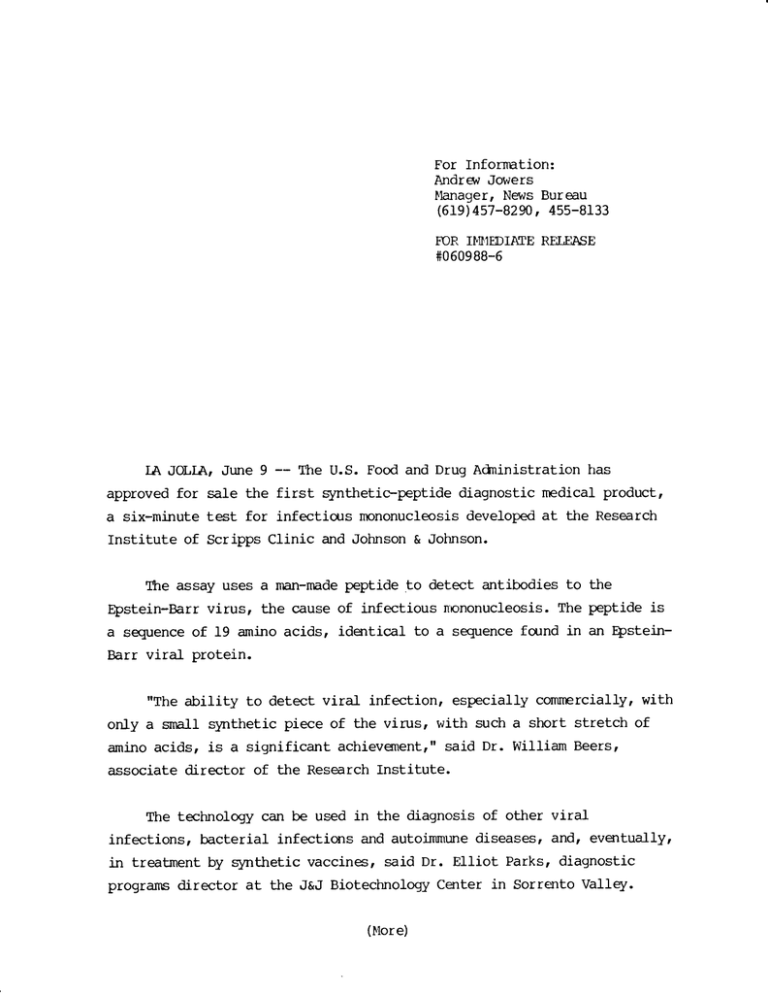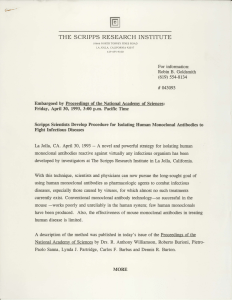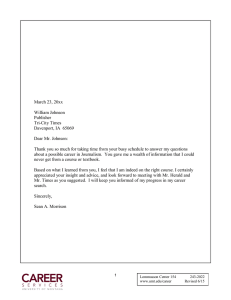For Infornation: Andrqp Jowers llanager, News Bureau (619)
advertisement

For Infornation: Andrqp Jowers llanager, News Bureau (619)457-82W, 455-8133 FOR II'$IDIAIE #060988-6 REIEASE IA JOLIAT ,June 9 -- The U.S. Food and Drug Adninistration qmthetic-peptide approved for sale the first a six-minute Institute test diagnostic medical product, for infecticr.rs mononucl-eosis developed at the Research and Johnson & Johnson. of Scripps Clinic Ttre assay uses a nnn-nade peptide to detect Epstein-Barr tras the cause of infectious virus, a sequence of 19 amino acids, identical antibodies to the nrononucl-eosis, The peptide is to a sequence fcund in an Epstein- Barr viraL protein. "The abil-ity only a snnll to detect viral slznthetic piece of the virus, amino acids, is a significant associate infection, director especially comnercially' with such a short stretch with of achievsnentr" said Dr. William Beerst of the Research Institute. The technology can be used in the diagnosis of other viral infections, bacterial infections in treatment by slmttretic prograns director and autoimmune diseases, and, evertually' vaccines, said Dr. E11iot Parks, diagnostic at the JaJ Biotechnology Center in Sorrento Valley. (llore) Page 2 June 9, 1988 #060988-6 Indeed, several nrore Johnson & Johnson diagnostic Scripps Clinic approval this products using technology are being developed and may be given FDA year, Parks said. Research Institute investigators identified the slznthetic peptide, in 1983, constructed the amino acid sequence and licensed the technoloqz to Johnson & ,lohnson. The peptide was developed as a corunercial- test by the J&J Biotechnology Center. Research Institute involved in the project investigators include Drs. Dennis Carson, Gary Rhodes and John Vaughan, basic and clinical research departrnent, and Dr. Richard Houghten' molecular biology deSnrtment. Tlae researchers, when studying the possibl-e role of the Epstein-Barr noticed an unusual sequence of anjno acids in rheunntoid arthritis, virus in Ltre viral protein. lrJhile most proteins several of the approxinately protein has a I9-amineacid 20 varieties fight that the EpsteirBarr The qmthetic acute antibodies, the Epstein-Barr amino acids. reslnnded to that squence of 19 anino said Rhodes. "Those antibodies off of amino acids' sequerce with only b,vo different "We l-ooked for antibodies acidsr" have sequerces containing were those t}re body produces to virus." peptide binds to and detects two antibodies: that are the first or convaLescent antibodies, to appear after infection; that aplEar l-ater and nny last l-ifetime. (l"1ore) IgPl' or and IgGT the lntient's Page 3 June 9, 1988 #060988-6 If shows a greater the assy reslDnse by IgIl antibodies than by IgG the Sntient has npnonucleosis. If the IgG antibodlz restrnnse is the trntient has had previo.rs exlDsure to the g>stein-Barr virus antibodies, greater, and is probably irmune from contracting rnononucleosis if reexposed. The assay - known as Ortho t"lonolert and narketed by Ortho Diagrnstic Systens, a Johnson & ,Johnson sdcsidiary based in Raritan, N.J. - is the product to reach the narket as a result first of a 1983 agreement between Scripps C1inic and Johnson & Johnson. Under ttris agreement, the pharnaceutical in return investigations applications for first-refusal- rights more sensitive, two yearsr rather tests are thaL it synptcrns similar in drildren, especially is has a shelf life of gives trntients nprecorclusive or leuksnia, two diseases with than a fer weeks, dnd it evidence that they donrt have hetrntitis to those of nrononucleosis. of 299 specimens, l"lonolert proved 98.8 trrercent test on corrfirmed cases of mononucleosis, while the traditional In clinical sensitive on comnercial of technology developed at the Research Institute. Advantages of the assay over existing significantly comlEny funds basic trials gave false negative results on 15 lnrcent of crrnfirmed casesr according to Orttro Diagnostics. About 10 percent to 20 percent of the U.S. population contracts fever, infectious sore throat aged 15 to 21 nrcnonucl-eosis' "the kissing diseaser" rarked by high and svelling of the lymph nodes. l.lore than 90 percent of U.S. adults have been extrnsed to the @stein-Barr have detectible antibodies. +.$+ lt ti lt virus' ard therefore




